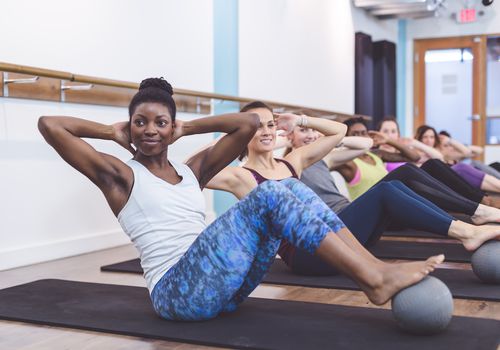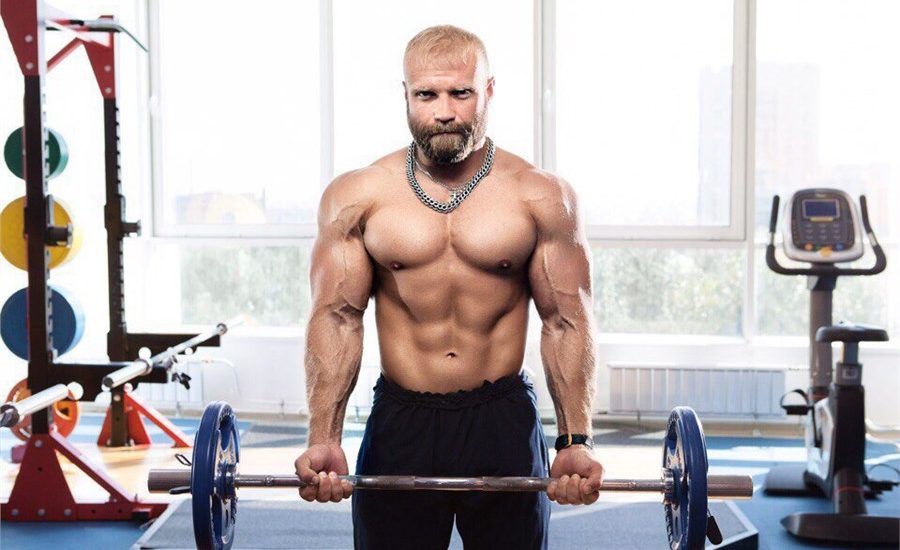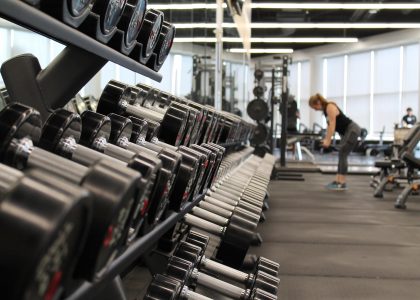In order to be able to learn the free handstand, 6 factors are essential.
You can find out what these are, how you handle them and what helps you to learn the handstand in this article.
You can then put together a plan and get started, or let me coach you on your first handstand.
But let’s start with the basics so that you know what you’re getting into when learning handstands.
The handstand – an impressive skill
When we talk about the handstand, we almost always mean the free handstand.
Free handstand means that only the hands touch the floor and we do not lean against a wall. That would be the handstand on the wall.
For the sake of simplicity I will only write about the handstand – but of course I always mean the free handstand.
In order to master it you not only need strength in your arms and shoulders, but also a lot of body control, self-confidence and most importantly: balance.Because Let’s be honest: a handstand on the wall also has something, but it is only really impressive if it is done freely and without a wall and ideally in a technically good shape. But more on that later.
Yes, strength is not the decisive factor, it is your sense of balance or sense of balance – but on your hands, not on your feet.
In this context we come to the demarcation of walking in a handstand. Well, that’s really cool too, but most of those who can do that rely purely on their strength and, for example, often don’t have the balance to stand still, let alone stand straight: Hello banana!
That’s not what we want.
We want to achieve that we can do a free handstand without using the wall and that we can stand upright for 10 seconds without having to do a handstand. That is the goal!
Then you can say that you have mastered the handstand.
And then things really start! For example, I’m currently working on the one-armed handstand. But that’s material for another article …
Now you’re here so I can show you the way to your first handstand.
Why should you even learn a handstand?
Maybe I’m a bit subjective because I just love this skill and train every day to improve it even further.
But hands on the floor, what do you get from learning the handstand:
- The best party trick
Let’s be honest: It’s just cool if you have mastered the handstand. - You improve your body awareness
To master the handstand, you have to “stack” your joints on top of each other. So that you can do that, you need a lot of sensitive feeling for your body and its position in space. - You increase your ability to balance
Just as it affects your right leg when you train your left leg (so-called cross education), a better balance on your hands also helps you to move in a coordinated manner on your feet. - A big goal in mind
Sometimes you can only change yourself if you work towards something that inspires you. The handstand can be something like that. Something that is worthwhile for you to watch your diet and exercise regularly. Something that will help you change. - Increased self-confidence
Through regular training you get to know your body better and better and you set new limits. This will increase your trust in you and your abilities and also help you in other areas. - More strength in arms and shoulders
No question, the main issue is balance, but you need some strength beautiful. Especially when you start experimenting with other skills like handstand push-ups. - Your mobility improves
By training for the handstand, you also improve your mobility in the wrist and shoulder joint . This is because you need to get into a good handstand position. In handstand circles this is also called “straight line”. - Can be done anywhere
All you need for your handstand training is a little space, a hard surface and you can start immediately ( well, a wall is also helpful at the beginning). That makes the training easy to do. - Feelings of happiness
When you can then do the handstand for a few seconds for the first time, it is incredible feelings of happiness. An event that will be remembered. You worked towards something and finally achieved it!
Are there any disadvantages?
Yes, yes.
There is of course a certain risk of injury, even if you train it properly – you will learn that here – as very low. Please also note my instructions.
You should also know that you need a certain basic level of fitness in order to be able to dare to do the handstand. You can find out more about this in the following chapter.
First things first: Reading this article is not enough.
You are allowed to work on yourself and your handstand skills over several weeks and months until you can achieve the 10 seconds of success mentioned. But it’s worth it, trust me.
All right, let’s get started!
Learn handstands for beginners
I want to be honest with you.
Not everyone can just get up from the couch and start learning to handstand.
At least not everyone should do that, simply because the risk of injury is too high.
But how do you know that you are ready to start handstand training?
Pay attention to the following points:
- You are not very overweight.
It becomes infinitely difficult to get your body on Balancing your hands when you carry around a lot of excess body fat. A guide value for me is definitely a BMI that is over 28. Everything below is possible, the closer to 25 or something below is optimal and learning handstands will be easier for you. Here you can calculate your BMI. Here you get tips on how to reduce your body fat. - You have a healthy wrist and shoulder joint
What does this mean for me: You can do at least 30 seconds in the starting position without any problems Stand still without pain in your wrist or shoulder. - The handstand is a must-have for you
Fall in love with the process and the results will come! That means: If you already learn to love the way to your goal, the achievement of goals will happen by itself.
You did the check for yourself and are you ready?
Good, then please take note of my advice and let’s get started.
Factor 1 – Mental Blockages
You may know that.
Change begins in the mind. But also fear.
Also with regard to the handstand.
You need a mental security that nothing can happen to you in order to be able to do a good workout.
This has to do with trusting your arms to hold your weight. If you’re having trouble bobbing your head down and feeling dizzy, it’s usually related to that. Don’t worry, it will get better with regular practice.
For example, first get into a pike position or into the downward facing dog. Just learn to put your head down and between your arms and slowly climb yourself up, placing your legs and feet higher and higher.
So first you leave them on the ground. Then maybe a knee-high elevation, then a waist-high elevation and if you are sure, on the wall in the stretched state.
The wall as security
As a somewhat advanced handstand student, you may have noticed that you can keep your balance close to the wall quite well, but that you can’t get on a green branch in free handstand.
There can be several reasons for this:
- In the free handstand, you have to kick yourself up first – keeping your balance is more difficult than if you just lift the weight relocated to the wall. In that case, read the chapter on technology.
- You take a run for the free handstand
This may seem logical, but it makes it more difficult to keep your balance. Just put your hands on the floor, make sure that your shoulders are over your hands and then try to do a handstand with both legs or one leg straight up. - You are afraid of falling or bumping your head. The wall gives you security, that’s why you succeed better there.
I can understand that well. The solution: Train the emergency solutions as described in the chapter on technology – i.e. how to get out of a difficult situation (before the attack).
So that we don’t get each other wrong: At the beginning the wall is your most important training partner. Only after you have trained for a few weeks does it make sense to try a free handstand.
Factor 2 – Mobility
A good handstand depends on sufficient hand and shoulder joint mobility. Your lower back also plays a role
Without that, you’ll always end up like a banana – or have wrist pain.
It is also important to warm up these two joints in particular before training for the handstand so that you are as flexible as possible and the risk of injury is reduced.
Focus on the wrist
When is the mobility in your wrist sufficient?
So you push your shoulders further in front of your hands on the floor. If you can hold this position without major problems, nothing stands in the way of your wrist learning handstand project.As a small test, you can go into the bench position and try to move your arms forward as far as possible reject that they are no longer at 90 degrees.
Focus on the shoulder joint
When is the mobility in your shoulder joint sufficient?
As a little test, you can lie on your stomach on the floor.
Then you stretch your arms forward and tilt your wrists so that your palms are facing forward (as if you were doing a handstand). Then tense your stomach so that you don’t arch your back, straighten your legs completely and also straighten your feet so that your instep touches the floor. Now you try in this position – your forehead stays on the floor – at the same time to lift your two arms away from the floor and at least to make it horizontal (like me in the picture).
Can you do that? Well, then the mobility in the shoulder joint is sufficient to learn the handstand.
Sufficient mobility and lumbar spine
What do I mean by sufficient in this context?
You can learn a handstand without being flexible enough. However, this is at the expense of elegance, at the expense of your joints and your strength. This means that you will not be able to stand in a handstand for so long because you will run out of strength sooner, you will be more likely to injure yourself and you will not be able to take a straight posture.
What’s up with my lumbar spine?
To get a straight handstand, you need to be able to straighten your lumbar spine. Too strong a hollow back would be counterproductive.
Just lie on your back.
You will find that there is some space to wipe your lumbar spine and the floor. You should be able to change this through targeted tensioning of the abdominal and gluteal muscles. So try to press your lower back all the way down to the floor so that there isn’t even room for a piece of paper underneath. You will need this movement later in the handstand.
All in all, mobility training also pays off when learning handstands. You are not ready yet and both tests were negative?
No problem – there are exercises that can help.
Factor 3 – Force
Amazingly, strength is not the decisive factor in learning a handstand.
But the more strength you have, the less your mental blockage will be because you feel more secure.
Strength (endurance) is particularly important for the muscles of the shoulder girdle and those of your arms.
Pikes or shoulder presses are a fine preliminary exercise to increase your strength. In my P.A.T. Bodyweight training I have 5 different levels of difficulty for you. Here is an excerpt so that you know which exercise I mean:
Alternatively: going up against the wall face down to the wall.
Linked to this: simply standing on the wall in a handstand. If you want to build strength in one position, you should use it often too. The wall – or a chair or table are your best helpers because you can support your legs and concentrate on developing strength without having to have the balance necessary for the handstand.
Important with all these exercises: not only work from your arms, but also from your shoulder!
The Hollow Body Hold – also known as the C + position – has proven its worth in order to guarantee core stability.That means: you actively push yourself out of your shoulders after stretching your arms.
You lie down on your back, tense your stomach and press your lower spine against the floor.
Then you raise your arms and legs, like I do in the picture, and hold this position as long as you can. Short break and again …
Factor 4 – Balance
If strength isn’t the deciding factor in handstands, what is it?
You guessed it: it’s the balance.
A perfectly formed handstand is a balance skill.
Balance is one of the coordinative skills that Meinel and Schnabel divide into 7 areas:
- Kinesthetic ability to differentiate
- Responsiveness
- Coupling ability
- Orientation ability
- Equilibrium or balance
- Ability to change
- Ability to rhythmic
This list makes it clear that it is not balance alone that makes a perfect handstand, but that, in addition to this most important coordinative ability, others such as reaction, differentiation and orientation also play a role.
There is indeed a transfer of your ability to balance on feet to that on hands, but unfortunately it is not 1: 1. This means that even if you can balance well on a slackline, you cannot do a free handstand on the floor.
Balance training for the handstand
You can only acquire this balance on your hands through one thing: Regular practice!
You have two options:
- You make the handstand easier
- You use a wall to help
With the frog handstand you learn two things: to balance yourself only on your hands and to carry your whole body weight only on your hands.
You can ease the balance requirements of the handstand by bringing your center of gravity closer to the floor. For example with the frog handstand.
You put your hands on the floor, bend your arms a little and then try to rest your legs on your arms so that you only stand on your hands.
If you do a handstand – also possible with bent legs – against the wall, you can also slowly try to detach your legs from the wall to stay in balance.
Both help you to train your ability to balance on your hands and slowly gain more and more confidence in it.
Factor 5 – Technology
A good technique is your life insurance when learning a handstand.
The “straight line” (how straight you are) and techniques for getting up and injury-free coming down play a major role here.
Swing up into the handstand
As mentioned above, you can get yourself into a handstand position by running up the wall.
But it only gets really cool when you can do it anytime and anywhere, because you have learned the “kick up”. That’s one possibility.
There are of course several. You can also jump from a crouch into the handstand or push yourself up – this is something for advanced users: the handstand press.
Let’s stay with the Kick Up.
Learn handstand without swing
Many people make the mistake of believing they need a run-up to get into the handstand. The problem with this: The swing is almost impossible to control and you will only stop in a free handstand in a few cases.
Better: you put your hands on the floor, arms straight. The shoulders are already vertically above the hands and from this position you push yourself off powerfully with one leg. The other leg acts as a swing leg. Alternatively, you can also jump up – so bend both legs and push off powerfully.
So you can slowly dose the impression so that you reach exactly the “sweet spot” where you neither fall back nor forward and then keep your balance with your wrists and shoulders.
At the beginning this will be difficult for you. But that’s not a problem either. In the beginning you should practice more with a wall anyway.
The better you get, the more feeling you get when you kick yourself up and soon you will be able to keep your balance for a second or two.
Troubleshooting – tips against robbery
For example, there are two ways to be armed against being assaulted on the back. You should simulate them again and again so that you can actually call them up in an “emergency”.
- Learning to roll down
This is particularly possible on a soft floor, you could then lie down on a mat in front of you to practice. When you feel that you are falling over, slowly bend your arms, bring your head towards your chest and then bend your arms as slowly as you can to elegantly roll off and land on your feet again. - Handstand wheel
The more elegant method that can also be used without a soft floor. You will quickly find out the better side for yourself – mostly you turn around your hand, on which side you swing your leg. In my case, I turn around my left hand – so it stays on the ground. With my right hand I push myself a little and turn my trunk, then one leg after the other comes back to the ground. You can practice this on a soft floor.
If you master both of these strategies well, there is no need to be afraid of being mugged.
The correct posture in the handstand
Good body tension is an important basic requirement. But that’s only half the battle.
The three most important points for a “straight line” when doing a handstand – that is, that you are standing as straight as possible:
- Push
Push yourself out of your shoulders in a really active way – do not bag , but actively push it out, your head must almost be wedged between your shoulders. - Point & Stretch
Your foot should not be angled like if you were standing, but rather like if you were standing on tiptoe. That means you tense your calves and let your toes point to the ceiling. At the same time you let your knees point forward and stretch your legs completely. - Belly in
The third tip for the perfect posture relates to a slight tilt of your pelvis to get one To avoid a hollow back and to get a straight posture. To do this, you pull your navel towards your spine. The pelvis then automatically tilts a little too.
The cool thing: You can also practice this posture perfectly while lying down (prone position) and on the wall (stomach to wall).
Simply take the respective position and then go through the steps step by step from Push to Point & Stretch to Belly and internalize them so that you can call them up later if you only carry your weight on your hands.

Factor 6 – handstand exercises and regular training
What would your training look like if you wanted to learn the handstand?
The most important factor: continuity.
In a year you will wish you had started today. Karen Lamb
Regular training not only helps you to prepare your muscles and passive structures for the handstand, but also develops your balance ability better and better.
Step by step you will experience a sense of achievement that will also be a good support for you when you stick with it.
If you already train regularly, you can incorporate handstand training directly after the warm-up and before your actual strength training.
If you don’t train that often yet, or if you generally want to hold your own handstand sessions, nothing stands in the way of you.
Before you stand on your hands and work on your balance, however, you should plan a few weeks for preliminary exercises.
The right surface for balance exercises
When you then work on your balance, it is important that you use a hard surface to give your hands the opportunity to get tactile feedback from the ground, which can then flow back into the smallest balancing.
So don’t train your balance on the meadow, but make sure that your hands are placed on a solid surface.
This is the only way to develop a good sense of balance on your hands in the long term.
Preliminary exercises to strengthen your strength
I already introduced you to the shoulder press above. This exercise is your life insurance if you want to learn the handstand.
Because with enough strength in your arms, you can master difficult situations upside down.
In my free training plans and also in P.A.T. Bodyweight training is included with this exercise.
Choose your level and do 2-4 sets of 8-12 repetitions. The last repetition should be really difficult for you.
Preliminary exercises for better body tension and a good body feeling
The Hollow Body Hold has proven its worth here.
I also introduced him to you above. Choose the level of difficulty so that you can last 30 seconds (not much more) and do 2-4 sets.
You can vary the level of difficulty by stretching your arms and legs more (more difficult) or more bending them (easier).
Preliminary exercises for strong wrists
Animal Athletics movements are ideal here.
Above all, the Beast Walk – walking on all fours with your knees slightly off the ground – has proven itself. You can also incorporate this exercise into your warm-up.
If you can, the frog handstand would also be a good training option.
The best thing to do is to put a mat in front of your head so that you don’t bump it on the floor and slowly lift one leg off the floor. Try to stand as long as you can, pause and repeat 2-4 times.
Learning to do handstand as skill training before the actual workout
As you already know, the handstand is a balance skill.
That means it will be exhausting, you will not exert yourself so much that you can no longer do strength training afterwards.
You can incorporate 10 to 15 minutes of concentrated handstand training after the warm-up. It would look something like this:
- Warm up 5-10 minutes
- Garnished with exercises for wrist and shoulder joints such as beast walk, position drills on the floor, shoulder circles, etc.
- Skill training handstand 10-15 minutes
- Preliminary exercises such as hollow body hold, balance drills, handstand on the wall, tucked handstand, frog handstand, etc.
- Your actual training (e.g. strength training)
- Cool Down
A great way to save time and still make progress.
Learn handstand in a separate training session
A proper handstand training session doesn’t have to last longer than 30 minutes. If you can incorporate 3 to 4 of these into your life per week, you will be able to hold the handstand for at least a few seconds in a few months – you should plan on an average of 2 to 3 months.
Remember that you should first acquire the basics of strength and core stability over a period of a few weeks before you try the balance exercises.
The first few weeks could therefore look like this:
- Training your wrists with Animal Athletics exercises
- 2-4 sets of shoulder presses
- 2-4 sets of hollow body holds
When you have trained yourself on a good basis, you can start learning the handstand step by step in terms of balance:
- Handstand with your stomach facing the wall
- Handstand with your back to the wall
- Free handstand
This order is important if you want to learn good handstand posture.
It is tempting at the beginning to swing your back against a wall. The problem with this: You will make a strong hollow back and it will be difficult to correct that later.
Better: you slowly walk up the wall with your feet with your stomach facing the wall and try to get closer and closer to the wall with your hands.
Excursus: Running in a handstand
You don’t really want to learn a free handstand, but rather to be able to walk in a handstand?
In fact, this is much easier than doing the free handstand because the balance component is almost eliminated.
If you learn the handstand, you will not be able to avoid taking a few “steps” with your hands anyway. This also protects you from getting into uncomfortable situations and bumping your head.
You don’t have to train it extra – it happens in the course of learning to handstand anyway.
Still a short guide:
First, you run in the direction of your back. Later you can walk sideways or whatever you can think of.
If you notice that you are getting overweight, shift your weight very slightly to one side and lift the hand on the other side and quickly put it back on about 10 cm further forward.
Try to keep your body tension as good as possible!
Then the same on the other side. If you practice this over and over again, you will quickly notice that it is not that difficult if you have the other requirements – especially strength – with you.
Don’t make the mistake of starting here, but work on the free handstand first, as this is the only way you can train yourself the necessary balance.
The P.A.T. Handstand system
My handstand journey really started in summer 2016.
Without knowing much about it, I just got started.
I was able to walk in a handstand back then, but just standing still was an impossibility for me.
You can follow my trip on Instagram.
Here is a picture from summer 2016: The free handstand was only possible very shortly after I pushed myself off the wall. My kids enjoyed it too.
After years of training in a relatively unstructured manner, at the end of 2019 I came to the decision to put more professionalism into handstands.
Then I have:
- Attended a training course at the brilliant Yuval Ayalon
- and worked through all sorts of books and websites I found on the subject of handstands.
The result was impressive:
The cool thing about it: The handstand is such a complex skill that it never has to stop developing. As with me: I can still work on a better “straight line” – that is, how straight my handstand is. In addition, there is also the big dream of the one-armed handstand, which I am pursuing.
I would like to make all the knowledge from the last few years available to you if you also want to learn the handstand.
I wish I had what you got in P.A.T. Handstand (I’m working on it – when it’s finished, you will be the first to find out as a newsletter subscriber – register here), had it from the start, so I would have been saved a few detours.
Conclusion and summary
You now know everything that is necessary to learn a free handstand.
What else you should bring with you: Patience!
It doesn’t happen overnight, it takes weeks or months, but you will notice successes step by step and get better and better.
Make sure to master the following factors:
- Mentales
- Mobility
- Kraft
- Balance
- Technology
- Continuity
If you like, I will help you with P.A.T. Like to handstand this way and accompany you to your first 10-second handstand without a wall. Simply register for my newsletter and you will be the first to know when the time has come and the course starts.
I look forward to seeing you on hands.







